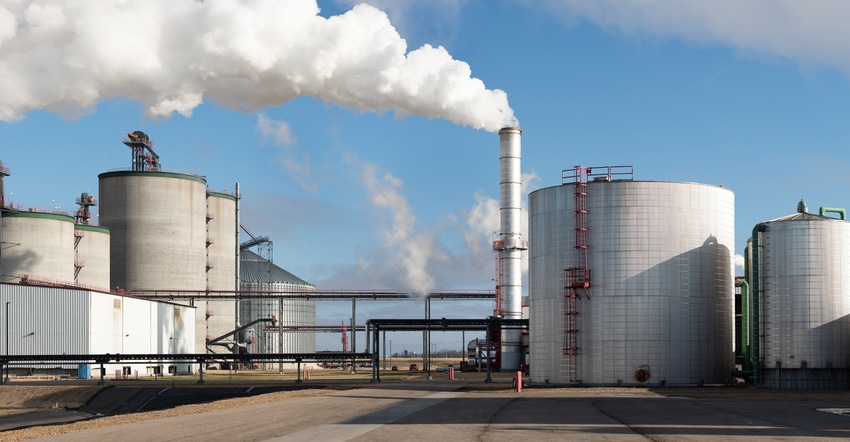
As ethanol prices hit records lows and ethanol plants either close, shutter or reduce capacity, farmers who raise corn are trying to ride out the latest tidal wave, this one caused by COVID-19.
Prior to the pandemic, farmers raising corn and selling to ethanol plants have also been battered about by low prices, reduced exports and failure by the U.S. Environmental Protection Agency to implement the renewable fuels standard deemed by federal law.
Related: Complete coronavirus coverage
According to news reports citing the American Coalition for Ethanol (ACE), ethanol production levels for 2020 are expected to be down by 4 billion gallons.
Minnesota corn and soybean grower Richard Syverson, Clontarf, Minn., said all farmers are getting hit hard with the impact of COVID-19 and reduced demand for ethanol production, from corn farmers who grow the product to livestock farmers who feed distillers’ grains to their animals.
Thus far, Syveson’s ethanol plant, Chippewa Valley Ethanol Co., continues to need corn.
“On our farm, there’s still have a delivery requirement,” Syverson said.
CVEC is one of the oldest ethanol plants in the state. A number of years ago, CVEC’s board decided to diversify its product line and started making industrial and food-grade ethyl alcohol and organic alcohols. Recently, CVEC as well as a few other Minnesota ethanol plants have been in the news for their production of sanitizers. Ken Colombini, communications director for the Renewable Fuels Association, said in a news release that sanitizer demand has helped keep some ethanol plants open and operating. However, it does not provide a revenue center that will uplift the industry.
“It could help some plants individually,” he said. “I would not consider it a panacea for the entire industry.”
Significant barriers exist for some ethanol plants to enter the sanitizer industry, and Colombini said RFA has been working with FDA to modify a federal regulation that would enable fuel ethanol plants to increase production of the grades of alcohol suitable for hand sanitizer.
Plus, installing necessary equipment to switch over a plant to produce pharmaceutical-grade alcohol takes time. Some plants may not have the workforce either to make the transition.
The Minnesota Department of Agriculture released a guidance sheet for ethanol plants interested in producing sanitizer for donation or sale.
Planting intentions
Syverson usually plants his acreage with two-thirds corn and the rest soybeans. High pH soils and nematode pressure make it challenging to raise high-yielding beans. He had prevented planting fields last year, which he had planned to sow with corn.
“When it’s planting time, that’s when I’ll know how much a can flex,” he said.
Harold Wolle, a Madelia, Minn., corn and soybean farmer, usually plants 60% of his fields in corn and the rest in soybeans.
“We’ll probably stick close to that this year,” he said. “It depends on the planting season and how it progresses.”
Wolle sells corn to two ethanol plants — Valero in Welcome, Minn., and POE in Lake Crystal, Minn. Both plants increased their basis so instead, he has been hauling corn to the co-op in St. James, Minn.
Along with the ethanol challenges, Wolle said he is concerned about COVID-19’s potential impact ag suppliers and if someone on his farm gets sick. That would have a major impact on getting work done.
Conscious of keeping hands clean, Wolle plans to stock each tractor cab with a bag of cleaning supplies containing hand sanitizer and wipes.
Federal help needed
On April 6, a bipartisan group of lawmakers sent a letter to USDA Secretary Sonny Purdue urging use of funds allocated to the Commodity Credit Corp. by the $2 trillion Coronavirus Aid, Relief and Economic Security Act to help the ethanol industry.
Minnesota senators Amy Klobuchar and Tina Smith participated in drafting the letter.
“The CCC was created to stabilize, support and protect farm income and prices while also maintaining balanced and adequate supplies of agricultural commodities and aids in their orderly distribution,��” the senators wrote.
EPA also recently heard from the ethanol industry. ACE urged the agency to address a shortcoming in the Renewable Fuel Standard implementation that was exposed as gasoline prices nosedived due to COVID-19.
At the time EPA set the 2020 RFS blending requirement and renewable volume obligation, the agency had projected gasoline demand would approach 143 billion this year, ACE said. However, due to the social distancing, gas demand has fallen, leading to reductions in ethanol blending.
The ACE letter to EPA outlines steps the agency has the authority to take to ensure meeting the blending requirement.
“If EPA fails to act, this reduction in ethanol use would correspond to a loss of between 350 and 700 million bushels of corn demand,” the ACE letter stated. “This would cost ethanol producers over $2 billion based on the six-month average price and farmers over $1.35 billion in 2020 according to current pricing information.”
Read more about:
Covid 19About the Author(s)
You May Also Like






